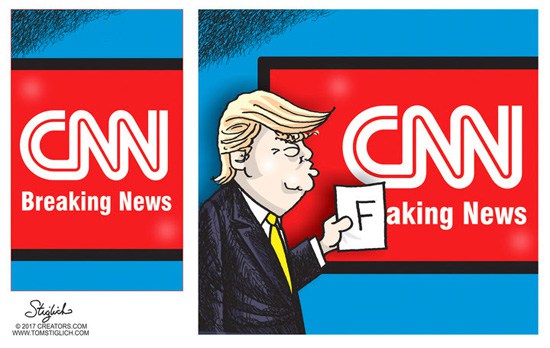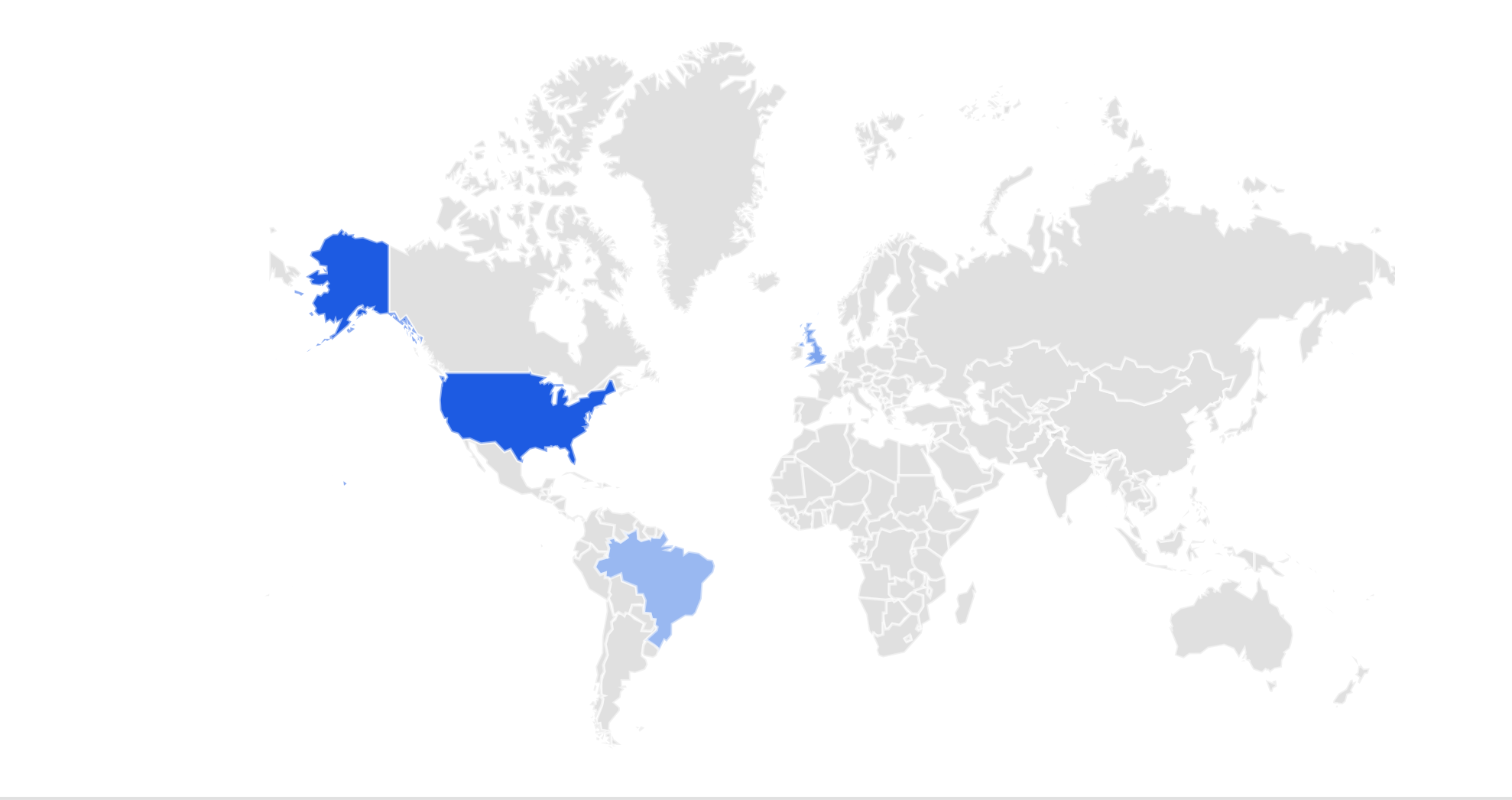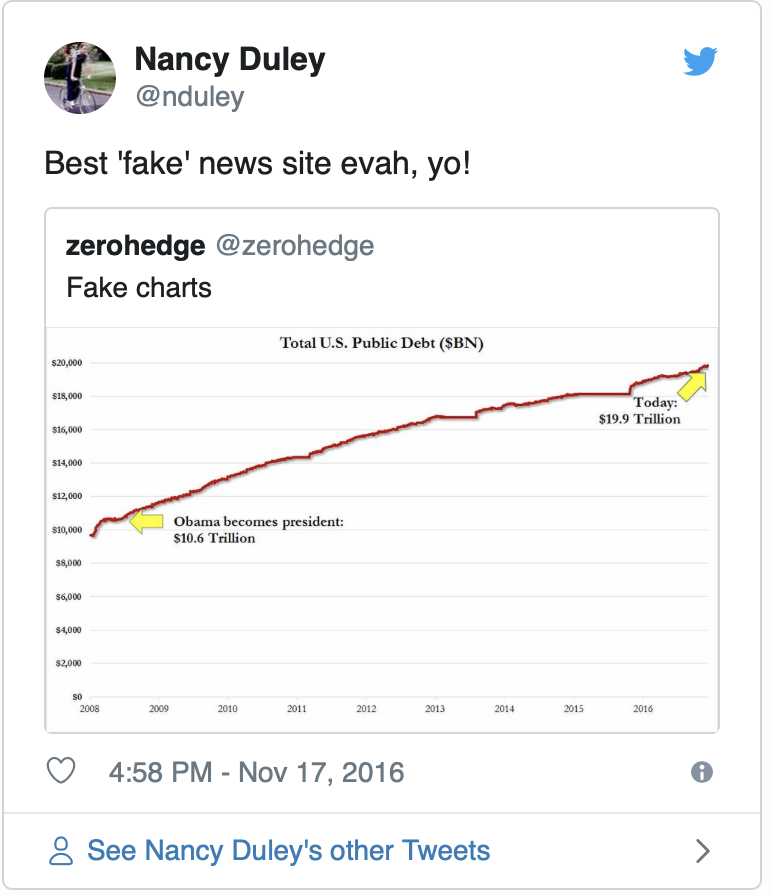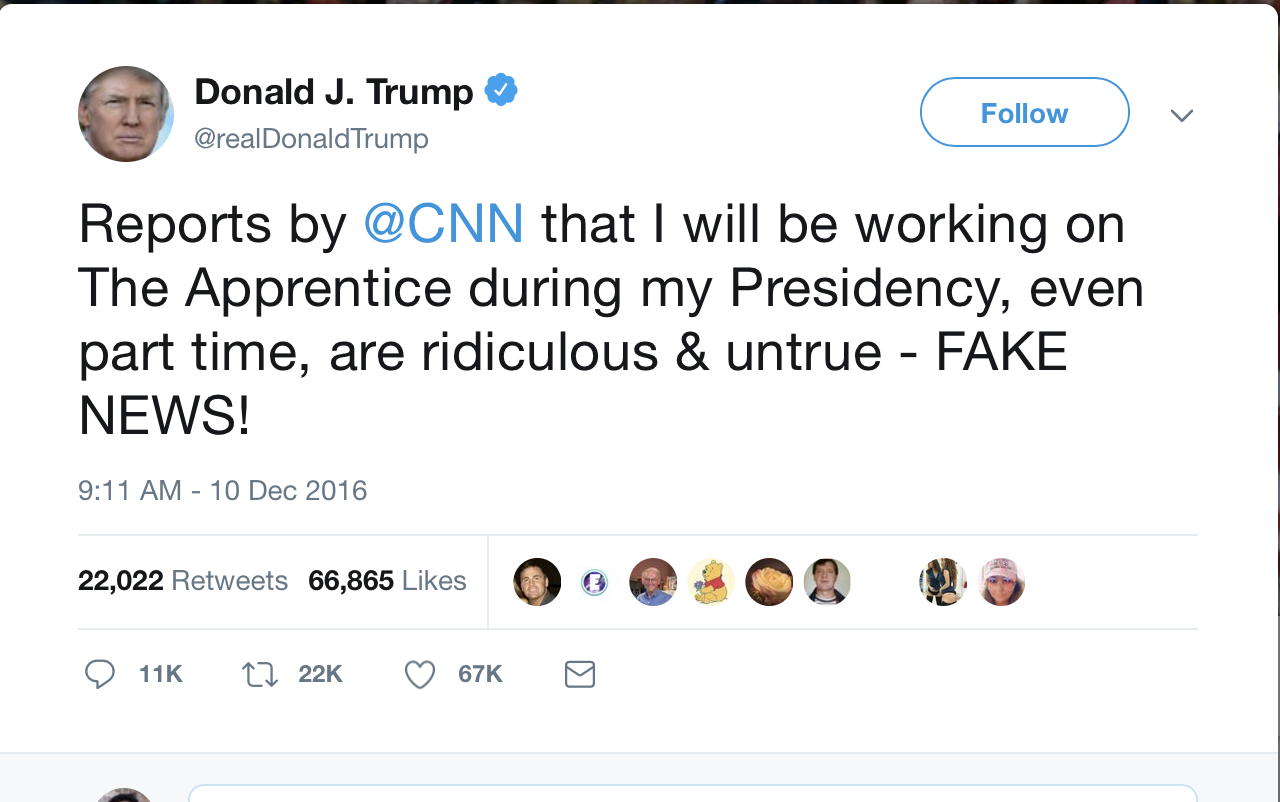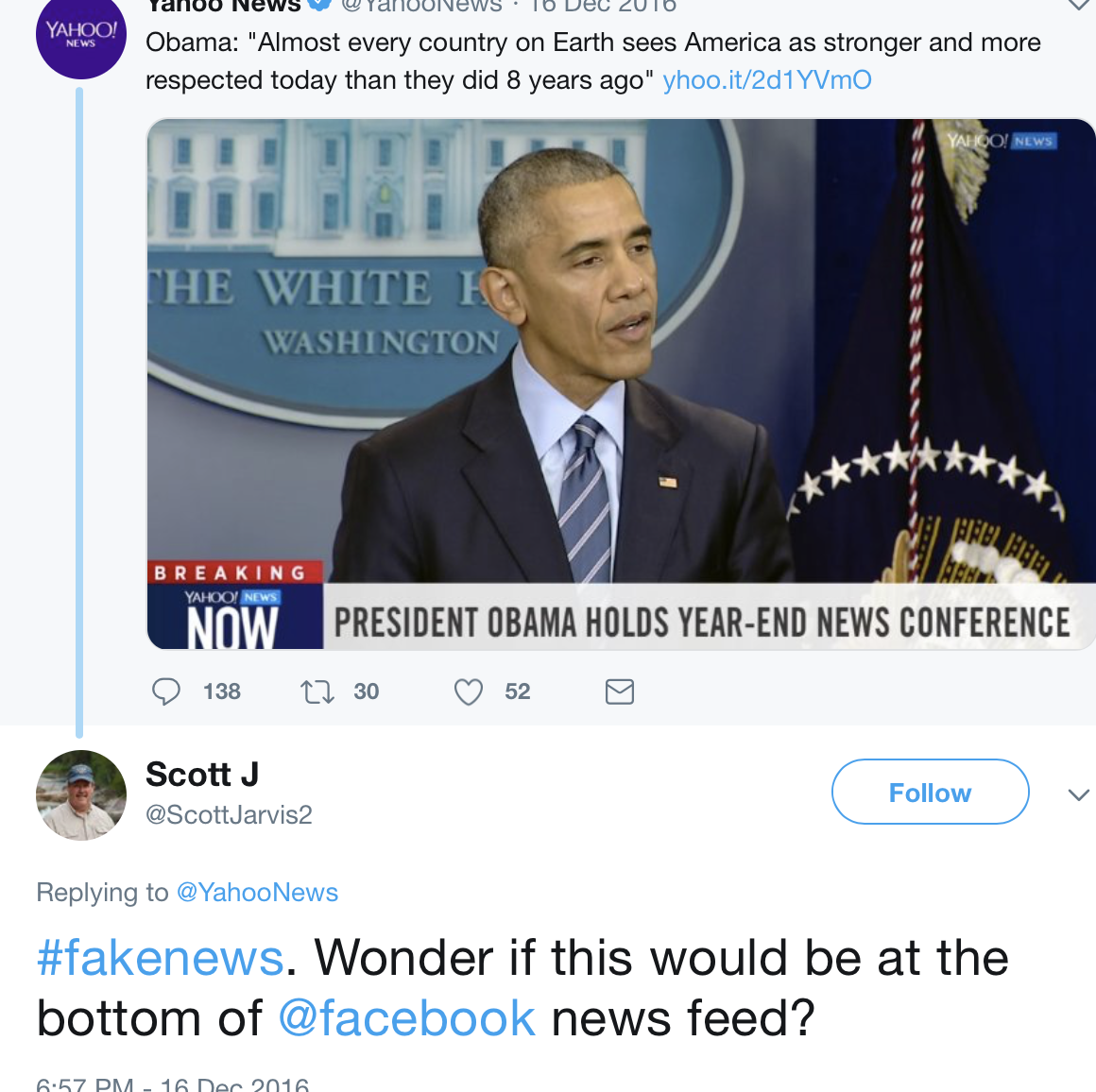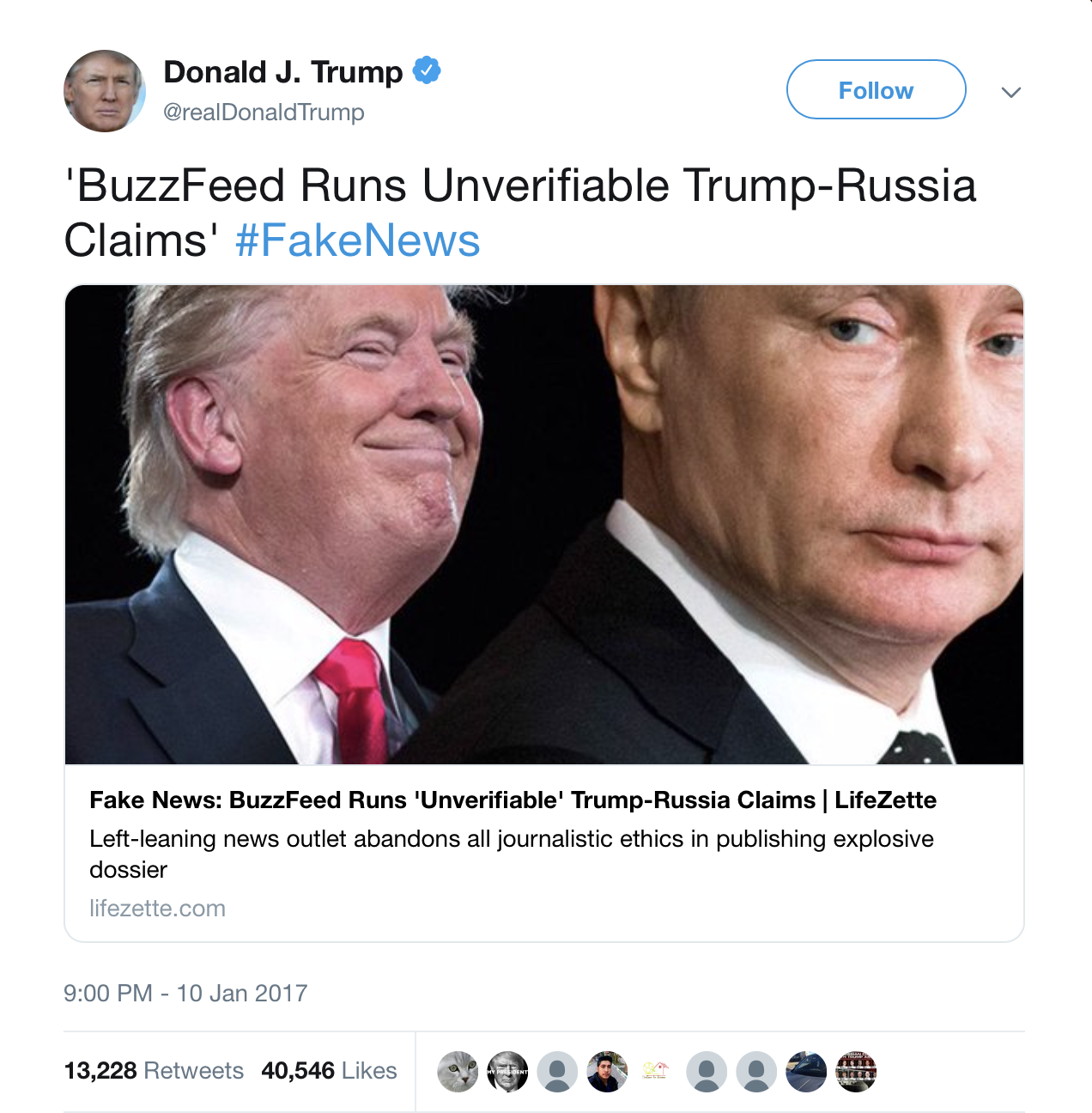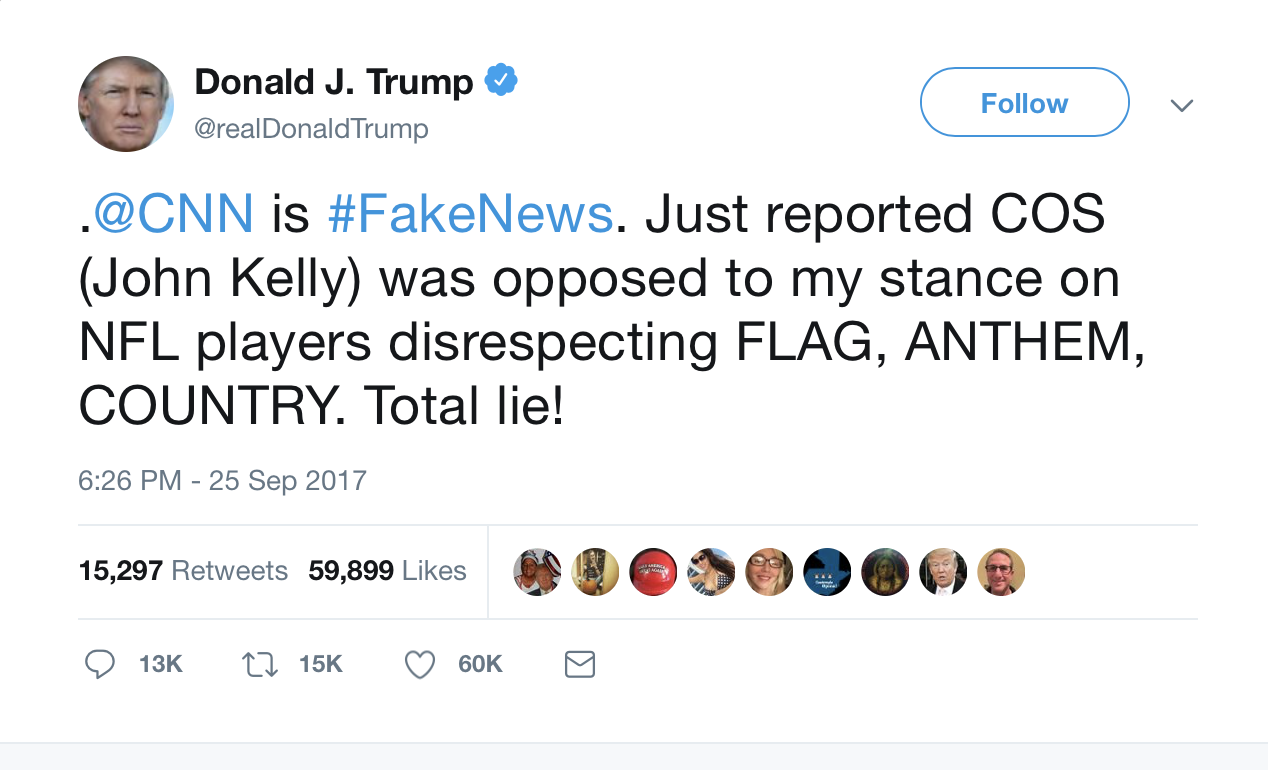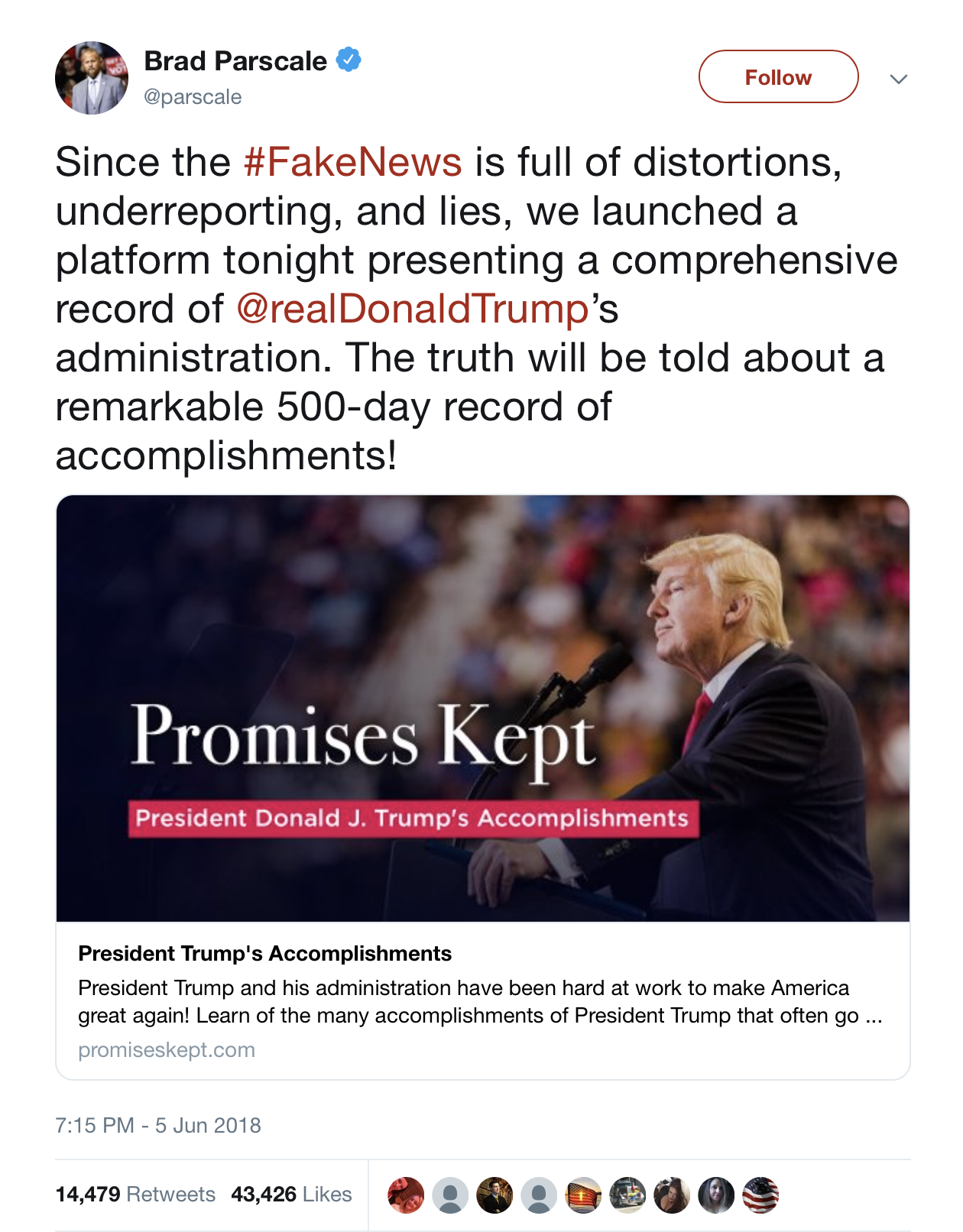PAGE NAVIGATION
- Introduction
- Context
- Key Actors
- Social Media Presence
- Offline Presence
- Impact of Movement
- Critiques of Movement
Introduction
Politically motivated disinformation (PMD) has existed for many centuries. Even before social media and the rise of #fakenews, PMD was present in books, news publications, ads, early television, and film. Fake news, the more commonly used and known phrase, is essentially any form of misinformation or lies that is created and distributed by an individual or group to either get an audience to believe in false information or to deceive them. Moreover, fake news can stem from the intent of creating clickbait rather than deception, which is defined by Merriam Webster as “something (such as a headline) designed to make readers want to click on a hyperlink especially when the link leads to content of dubious value or interest.”[1] “Yellow journalism” in North America during the 1800’s and the “Lügenpresse” or lying press in Nazi Germany during World War 2 are just a few historical examples of fake news.[2]
The hashtag, #fakenews, erupted on social media after the word was used ubiquitously during the 2016 Presidential Election by pre-elect Donald Trump.[3] During the election, fake news became a hot topic circulating candidates Hillary Clinton and Donald Trump. Throughout election season, there were many fake news articles being published about both candidates. For instance, there were claims that Pope Francis endorsed Donald Trump and news posts were being circulated claiming Hillary Clinton approved weapons sales to Islamic jihadists, “including ISIS.”[4][5] Likewise, there was pro-Hillary fake news suggesting that Trump had formerly called Republicans “the dumbest people.”[6] The impact of such fake news led a to nationwide distrust in public media. Social media empowered #fakenews to be used rather negatively, pitting opposing parties against each other. The usage of #fakenews on social media stirred a movement of constant vilification of mainstream media, grew an attitude of denial, and enabled the support of unverified claims. Rather than a progressive movement, #fakenews is a regressive movement for the nation as a whole. The power of social media enabled #fakenews to be used as weapon by people on opposing sides of the political spectrum to publicly shame and discredit their respective opponents, without regard for facts rooted in reality.
Users of Twitter and Facebook, especially during 2016 election season, tagged news articles as #fakenews to indicate any news that they found blatantly wrong or against their views. Currently, the hashtag is commonly used to attack mainstream news outlets, and as a mechanism to defend personal arguments and opinions and claim others’ as false.
Geographic Mapping
Over the past 5 years, the word “fake news” has been used internationally, primarily in Brazil, the Philippines, Germany, the United States, and Canada.[7] The word became increasingly popular at the end of 2016, and has maintained relatively constant relevancy ever since.
(The following image shows the relevancy of the keyword “fake news” over the last 5 years)
#FakeNews erupted in the United States at the end of 2016, specifically during election season.[9] The first tweet with #FakeNews popped up in 2016 with an individual from Colorado attacking Yahoo News.[10] Since then, the usage of the word “fake news” and the hashtag has become more of a national term, gaining popularity in the United States.
(The following image shows the prevalence of “#FakeNews” in the United States)
Context
Historical
Pre-Social Media Era Timeline:
| Year | Event Title | Event Description |
| 1493 | Invention of Gutenberg Press | Invention of the Gutenberg Press was the start of the dissemination of news to the vast public. At that time, many news stories went un-verified. |
| 1835 | The New York Sun Hoax | The New York Sun claims life on the moon. This is an example of a famous news hoax that spread to the public via a popular news outlet.[15] |
| 1913-14 | World War I Propaganda | World War I propaganda was spread out to win the sentiment of men to join the army |
| 1939-45 | Anti-Semitic Propaganda World War II | The spread of anti-Semitic propaganda by the German claiming Jews as evil people |
| 1983 | President Reagan’s STAR WARS plan | The United States schemed and publicized the STARS WARS defense initiative to scare the Russians into believing the US had advanced weaponry[16] |
| 1990s | Rise of Satire on TV | Satirical late-night talks shows and news publications like The Onion became very popular and spread untrue stories about celebrities and politicians |
Social Media Era Timeline:
First usage of the term Fake News on Twitter by Donald J. Trump First usage of the hashtag #FakeNews on Twitter by user ScottJarvis2 in response to a Yahoo News post [17] Donald Trump using #fakenews hashtag during the controversial kneeling during the national anthem situation Campaign manager for Donald Trump using #fakenews to discredit all the false news stories regarding President Trump
Political Spectrum
The hashtag #fakenews has been used by both sides of the political spectrum. In 2016, people favoring Leftist news outlets (i.e. CNN) were using the hashtag to attack Rightist (i.e. Fox News) news outlets in favor of Donald Trump. Many on the Left claimed that the Right used PMD and fake news to heavily influence the election, which led to Donald Trump’s win.[23] Likewise, those on the Right, including Donald Trump, heavily used #fakenews against Left news outlets like CNN and berating them on fake news regarding Trump’s campaign. For a few months after President Trump’s inauguration, many liberal news outlets brought up and publicized Trump’s illegal cooperation with the Russians to rig the election and, ultimately, discredit his presidency. In response, President Trump and his team discredited all such claims through many public announcements and social media postings. Tweets with #fakenews were primarily used by those on the Right against the Left because President Donald Trump was a strong advocate of the hashtag and the usage of the word “fake news” against liberal, left news outlets in many of his press conferences.
As of recent (April 2018), with the conclusion of the Robert Muller’s investigation, there have been an eruption of #fakenews posts on Twitter by many Republicans and right-wing individuals. With the Muller investigation concluding that there was no collusion between Trump’s campaign and Russia, many Right individuals have been using the hashtag to disprove all the old news articles that claimed otherwise.[24] Nonetheless, Democrats and other Leftist individuals have also been using the hashtag to claim that the Mueller investigation was internally rigged.
Location/Affiliation
Since a majority of the #fakenews movement takes place online, there is no centralized location for the movement. People participating in this movement have different affiliations with various groups and organization. There is no primary organization heading the #fakenews movement. Additionally, the active online community has appealed to users globally; however, the movement doesn’t generate impact on any specific physical locations.
Key Actors
People: A major actor that started the popularity of the hashtag #fakenews would be President Trump. The first appearance of the term “fake news” in Trump’s twitter account was used to accuse CNN of promoting misinformation on Trump’s presidency. Quickly, the term became intensively popular on Twitter and was used by people to label content that they believed was “fake news”. Additionally, President Trump has been using the words “fake news” in various conferences and on social media platforms. Trump’s usage of the word and hashtag was a huge impetus for other people’s usage of the hashtag on social media.
In addition to the influence of President Trump, social media and the traditional media industry also play important roles in the spread of misinformation. For instance, platforms like Facebook and Twitter are the major sites where false content get promoted and shared. In the face of these developing trends, social media platforms need to recognize and identify sources that produce or perpetuate fake news. Without the effort of these social media platforms, users are more likely to be exposed to and influenced by misinformation on these sites.
Demographics: Since the movement itself starts and spreads on various social media platforms, individuals who are able to participate in this movement can be dramatically different from that of other social movements. Since over 60% of Americans access news on social media, these active online users are more likely to be exposed to and engaged in the discussion of fake news.[25]
Organizations: The ideology of fake news has become extremely popular on social media, especially on Twitter; this was primarily due to the increasing concern for the impact of fake news on the presidential election. The hashtag started organically, and is not claimed by any particular group of individuals. Rather, it a universal, ubiquitous hashtag that is used by many.
Social Media Presence
The movement did not stem from any one individual or organization. Rather, the hashtag erupted with no specific agenda in mind. It is interesting to observe how #FakeNews is now being used as a uniform tool by people to cause dissent among those with differing political opinions. Instead of being used to unite under a specific cause (i.e. #MeToo), this hashtag can often be used to divide people politically apart.
Key images:
(Political cartoon representing the harsh reality of how fake new is creating a divisive environment amongst groups of people)
(One of the most liked and retweeted post using “Fake News” by Trump, which shows how it was typically used throughout the election)
(A recent tweet by Republican politician Dinesh D’Souza about the New Zealand shooting, in which he is using the hashtag to promote his individual feelings and political agenda)
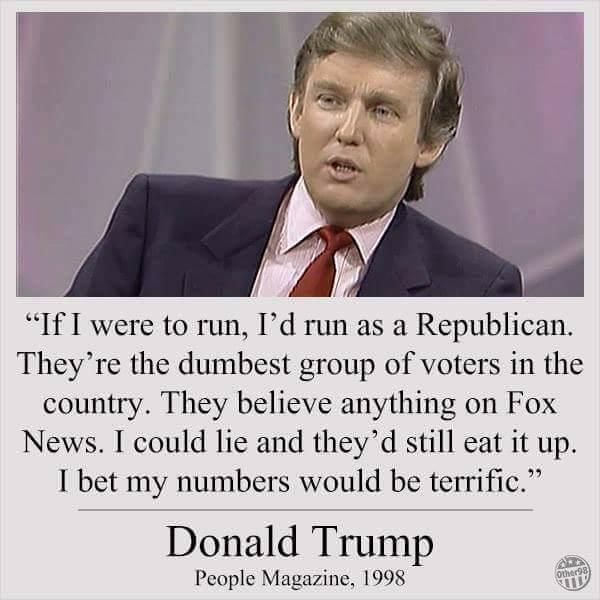
(One of the most spread “Fake News” Posts during the 2016 election through social media. Multiple sources including Snopes have proven this to be false) [27]

(One of the most circulated Fake News article headlines on Facebook with over 2 million engagements, simply with the purpose to be clickbait) [29]
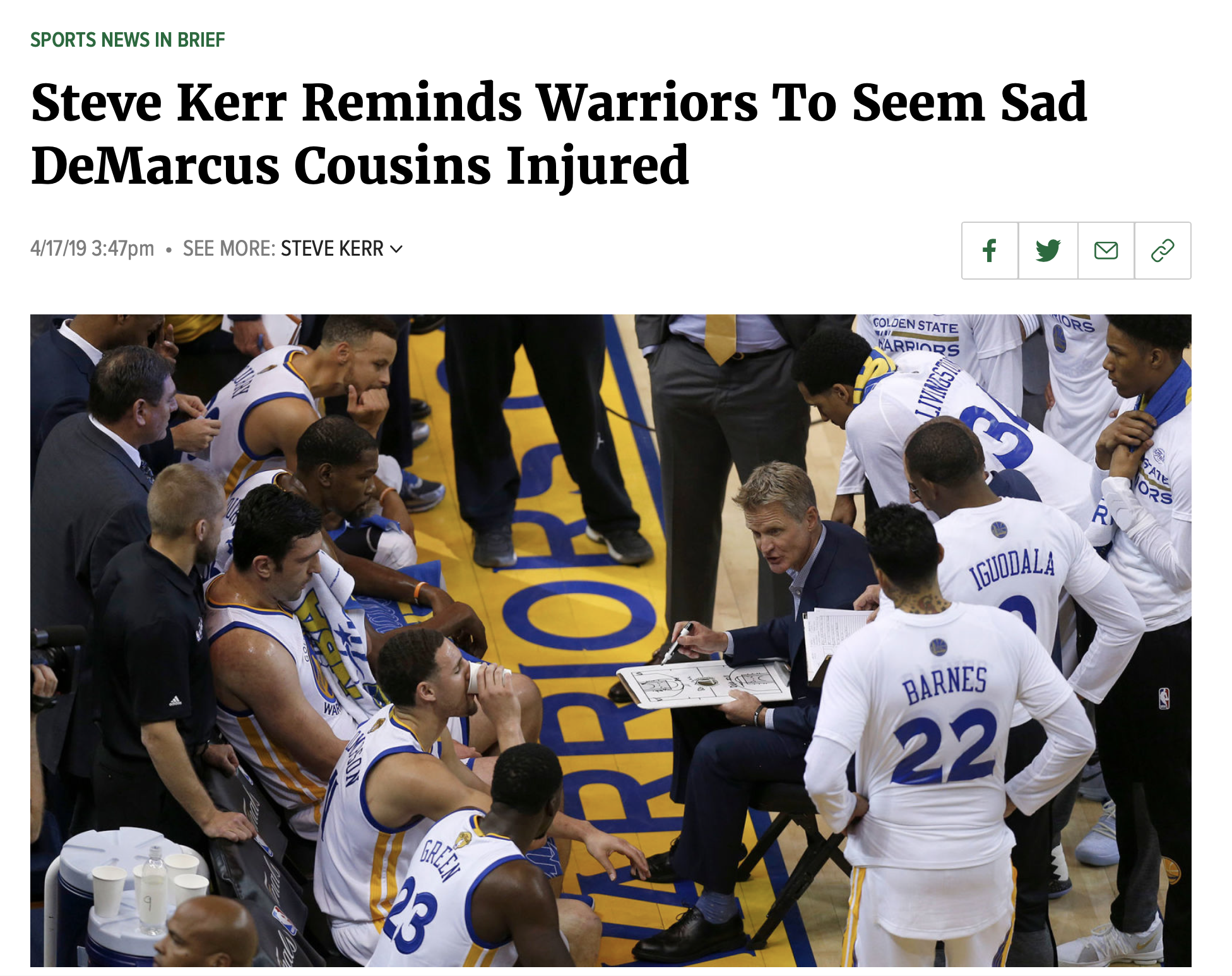
(An example of an article from The Onion, a satirical artificial news source with the purpose to provide humor to their readers)
Platforms and Statistics
Fake news has been in popular press for over 500 years, ranging from The New York Sun claiming life on the moon, to war propaganda, and even satirical news sources such as The Onion. However, the recent fake news movement and the hashtag #fakenews has spread significantly due to the power of social media. This movement has been extremely dependent on the social media platforms, especially Twitter and Facebook. In December 2016, Donald Trump first used the phrase “fake news” when referring to his role on the Apprentice during his presidency. Since then, the hashtag has been used thousands of times in many different contexts.[31] More specifically, Donald Trump, using his account @realdonaldtrump, which has 59.6 million followers, has used a variation of the hashtag in his tweets 416 times.[32] Common variations of the hashtag include “FakeNews”, “Fake News” and “#fakenews”, all of which demonstrate the same purpose.[33] According to RiteTag, the hashtag #fakenews is used in approximately 350 unique tweets per hour, resulting in a hashtag exposure of about 50,000 users and roughly 500 retweets per hour.[34]

(#fakenews Twitter hastag analytics from RiteTag.com) [35]
Furthermore, this usage of the hashtag has stemmed a further usage of the term to combat legitimate but unfavorable news of a particular position. This stems, as a result, from the anti-movement of fake news, and is also seen significantly on Twitter. Many individuals use the variations below to combat negative press or pursue their own political agenda, including several politicians such as Dinesh D’souza. As for other social platforms, Facebook was used as more of a platform to actually disseminate inaccurate news, rather than play a part in the overall movement. However, this indirectly also amplified the effect of the meeting by increasing the validity of the hashtag #fakenews.
Facebook is another platform that played a role in the #fakenews movement, emphasizing the increased need for validating news that users are looking at. [36] One example of this was the posting of a quote claiming that Donald Trump had said that if he ever ran for president, he would run for president because “[Republicans were] the dumbest group of voters in the country”. This was actually a fake quote, as displayed above. Fact checking platforms have grown in usage and importance as a result of this movement, aiming to make sure that individual users are able to tell what is real news from what is fake.
Memes
The impetus of the hashtag spurred a number of memes mocking the prevalence of fake news being distributed by news outlets and on social media. Most of these memes revolve around President Donald Trump claiming leftist-liberal news outlets as fake news. The origin meme occurred when President-elect Donald Trump refused to answer questions from CNN, Buzzfeed, and other news organization he claimed to be “terrible.”[37]
Social media is critical to the spread of fake news and the formation of the #fakenews movement. The movement itself starts with the recognition of false information on social media; platforms like Twitter make the spread of false information easy. For instance, research has found that political information can be shared and promoted faster compared to other kinds of false content.[38] In addition, people are more likely to retweet false tweets than truthful tweets.[39]
As people recognize the impact of fake news on democratic institutions, it generates a broad discussion on how to identify fake news. Not too long after President Trump’s usage of the term “fake news”, the movement of #fakenews continues to evolve. The movement itself took off due to an active virtual community, and it continues to remain active on social media platforms.
Organic vs. Planned Growth:
Unlike other social media movements, #fakenews grew organically. The hashtag gained popularity after many people, including Donald Trump, began to use the word in public conversations and on social media. The hashtag quickly became a method used to blatantly call out news publications. Many different politically-sided groups targeted new stories from outlets like CNN or Fox and brand them as #fakenews all over social media. Since so many new stories were being branded fake news, there was a distortion of reality that left people unable to clearly distinguish fake news from real news.[40] This movement has continued to impact many users as they interact with news sources online. Although it started out organically with increasing concern for the prevalence of misinformation, it has become more planned as more people have started to use #fakenews to attack any opposing opinion. This eventually led to the popularity of this movement as a regressive one. Meanwhile, this movement has led to the growth of research groups at universities to investigate such #fakenews articles, and the creation of machine learning and AI algorithms to identify fake news.[41]
Offline Presence
This movement was unique in the way that it started, where more typical movements such as #blacklivesmatter and #metoo stemmed from years of inequality and lack of rights, #fakenews stemmed from the widespread usage of the term, popularized by President-elect Donald Trump. His usage of the term, combined with his ability to blatantly lie allowed the fake news movement to grow as large as it has. One movement that may have played an indirect role as an antecedent was the #MAGA movement that started in 2016. The MAGA campaign resulted in Donald Trump winning the election, the vocalized rise of the alt-right, and a strong base of followers for Trump.[42] This group of followers were far stronger devotees than previous campaigns, and believed almost everything being said by Trump. Thus when he continued his unconventional campaign, eventually incorporating fake news as a campaign technique, individuals against presidential candidate Donald trump were just deemed as propagates of false news and haters of the movement to his supporters. Furthermore, the MAGA movement instigated a distrust of the status quo, which translated into a distrust of common media, a clear consequence of the fake news movement. Another concurrent set of events that had a large impact on this movement was Julian Assange and the wikileaks movement. WikiLeaks, an organization started in 2006, with no affiliation to Wikipedia, was built on a purpose to accept and “disseminate censored material of political, ethical, diplomatic or historical significance”[43] They pride themselves on only releasing 100% accurate documents, and have typically not violated this, but are seen to participate in political bias.[44] As for their impact on the Fake News movement, the first factor was that this movement caused a further distrust in the government due to the many documents and plans they were hiding. This distrust was then the impetus for further distrust in the media, as they had no awareness of many of the things WikiLeaks, exposed, which was a key aspect that the fake news movement capitalized on. Furthermore, a more direct impact can be seen with the documents that were actually realized during the time, specifically Wikileaks exposed many Hillary Clinton emails and of the conspiracy against Bernie in the Democratic National Convention rules.[45] This coincided with the fake news movement, further polarizing individuals on both sides of the political spectrum, and expanding the overton window on actions taken by governments and the possibility for common news media to be propagating fake news. In conclusion, the movement was quite atypical and for the most part a stand alone case, enhanced by the MAGA campaign and the impact of Wikileaks before it.
Impact of Movement
Policy achievements: Although #fakenews has gained lots of popularity on different social media platforms as well as on traditional media, it didn’t create many specific policy achievements in the United States. However, the movement did create many discussions and policies internationally. For instance, the Singaporean government is currently proposing a new bill to ensure that news outlets are held accountable for the spread of misinformation on its platforms.[46] More specifically, this bill is intended to regulate technology companies like Google and Facebook. Similarly, Russian President Vladimir Putin has signed a bill into law that makes it illegal to spread fake news, specifically focused on the distribution of information that “exhibits blatant disrespect for the society, government, official government symbols, constitution or governmental bodies of Russia.”[47]
Other achievements: The #fakenews movement has broadened the discussion of the legitimacy of news sources and content on various media platforms. As fake news and misinformation continues to spread in various media sources, people have been expressing their concerns on the impact of fake news in society and on democratic institutions.[48] Since the #fakenews provides a way for people to identify and target content that lacks reliable sources or evidence, leaving some positive attributes, but unfortunately this is not what the hashtag is most frequently used for. In addition, the increasing concern of fake news also has led to significant discussions on the ways to combat misinformation. Many social media platforms have employed different mechanisms to stop the spread of the false information. For example, after the 2016 presidential election, Facebook has made multiple algorithmic as well as policy changes on its site to prevent the promotion of false content.[49] Based on a report published by Stanford University in October 2018, researchers found that the mechanisms employed by Facebook has strong impact on reducing misinformation on the site. The engagement between its users and fake news sites has declined more than half since the placement of these new mechanisms.[50] With the possibility of lessening the impact of misleading information on social media, we are getting closer on preserving the reliability of news sources and better informing the general public.
On the other hand, the use of #fakenews on social media has changed significantly from its original intent. Originally the term “fake news” was used for questioning the reliability of news sources. However, it has since been used by political leaders to criticize the legitimacy of statements made by others in different parties. Currently, the #fakenews has been used primarily as defense mechanism to attack others who share different point of views. As a result, besides increasing the general awareness of false content in social media, the movement itself also exacerbates the division between between political parties among the general public, especially among those who dislike statements from different perspectives. Moreover, the over-representation of misinformation also has negatively impacted the relationship between the general public and mainstream media. Some people have blamed media platforms and news sources for the spread of fake news, which has lead to the distrust of media. In turn, this distrust of common news platforms has pushed citizens to only follow the information provided by sources that support their personal and political opinions.
Critiques of Movement
This movement has been significantly criticized by many individuals familiar with its impact and consequences. First, the more obvious effect of the recent prevalence of fake news is that it is now much harder to distinguish actual verified news from speculative artificial news. This is a result of the increased dependence of social media as our source of news, with more than 50% of news coming from social media.[51] Some fake news stories have spread over a million times and are believed by the majority of those who read it.[52] This means that people are more trusting of the news they want to hear, rather than all news; in addition to this, it is much easier to attempt to propagate false information on social media than traditional media sources. These articles are typically more inflammatory due to a purpose to confuse or generate clicks, otherwise known as clickbait, but are still quite difficult to assess to the common reader.[53] This is detrimental to society because people are unable to distinguish what is reality or fact-based, and it reinforces individual biases.
Similarly, the usage of #fakenews and the movement of distrust of common media has also been significantly criticized due to the potential consequences. The first aspect of this is the political landscape, and how politicians are using them to further persuade their agenda. Specifically, it has been used by both Republican and Democrats to defend their own arguments, or discredit their opponents.[54] Now, supporters of any political party have the realistic possibility of deeming the opposing perspective as “fake news”. As a result of this, it had indirectly promoted an attitude of denial, and lack of responsibility. The impact of this is that it has built a public distrust of traditional media sources, as many respected individuals allude to fake news when seeing articles they do not agree with: this results in groups leaning towards only one particular news source as a basis of arguments, which eventually results in further dividing the public. Finally, the movement has also allowed outside influencers to more easily promote false information to further their political agenda. All of these are clear results of the movement, ultimately preventing the spread of accurate information, and promoting further division of political groups on apposing sides of the isle.
Author Biography
Samir Naqvi – Samir is a junior at the University of California at Berkeley studying Electrical Engineering & Computer Science, with an additional interest in Business. He has worked in the computer science and finance industry, and is interested in the role of technology in social movements.
Henry Guan – Henry is a fourth-year Social Welfare major at University of California at Berkeley. He is interested in learning about the impact of social movements in making policy changes. He will be working in the non-profit sector upon graduation
Siddharth Kumaran – Siddharth is a sophomore at University of California at Berkeley majoring in Industrial Engineering and Operations Research. He is interested in data science and financial engineering in the fintech sector. He is an avid social media user and is interested in learning about how social media empowers social movements.
_______________________________________________
Works Cited
[1] “Clickbait.” Merriam-Webster, Merriam-Webster, www.merriam-webster.com/dictionary/clickbait.
[2] Noack, Rick. “The Ugly History of ‘Lügenpresse,’ a Nazi Slur Shouted at a Trump Rally.” The Washington Post, WP Company, 24 Oct. 2016, www.washingtonpost.com/news/worldviews/wp/2016/10/24/the-ugly-history-of-luegenpresse-a-nazi-slur-shouted-at-a-trump-rally/?utm_term=.a78e0c69c81d.
[3] Grynbaum, Michael M. “CNN Corrects a Trump Story, Fueling Claims of ‘Fake News’.” The New York Times, The New York Times, 8 Dec. 2017, www.nytimes.com/2017/12/08/business/media/cnn-correction-donald-trump-jr.html.
[4] LACAPRIA, Kim. “FACT CHECK: WikiLeaks Confirms Hillary Clinton Sold Weapons to ISIS?” Snopes.com, Snopes, 13 Oct. 2016, www.snopes.com/fact-check/wikileaks-cofirms-hillary-clinton-sold-weapons-to-isis/.
[5] Evon, Dan. “FALSE: Pope Francis Shocks World, Endorses Donald Trump for President.” Snopes.com, Snopes, 10 July 2016, www.snopes.com/fact-check/pope-francis-donald-trump-endorsement/.
[6] Putterman, Samantha. “No, Donald Trump Did Not Call Republican Voters Dumb in the 1990s.” Politifact, Politifact, 18 Dec. 2018, www.politifact.com/facebook-fact-checks/statements/2018/dec/18/blog-posting/no-donald-trump-did-not-call-republican-voters-dum/.
[7] Fake News. Google Trends. https://trends.google.com/trends/explore?date=today%205-y&q=fake%20news
[8] Fake News. Google Trends. https://trends.google.com/trends/explore?date=today%205-y&q=fake%20news
[9] Fake News. Google Trends. https://trends.google.com/trends/explore?date=today%205-y&q=%23fakenews
[10] #FakeNews – Who Said it First on Twitter. CTRLQ.org. http://ctrlq.org/first/104276-fakenews/
[11] Fake News. Google Trends. https://trends.google.com/trends/explore?date=today%205-y&geo=US&q=%23fakenews
[12] Editorial News Cartoon. Tumblr.com. https://www.tumblr.com/search/editorial%20news%20cartoon
[13] Trump, Donald J. “.@CNN Is in a Total Meltdown with Their FAKE NEWS Because Their Ratings Are Tanking since Election and Their Credibility Will Soon Be Gone!” Twitter, Twitter, 12 Jan. 2017, twitter.com/realdonaldtrump/status/819550083742109696?lang=en.
[14] D’Souza, Dinesh. “Any act of terror is evil…how #FakeNews is made” Twitter, Twitter, 15 March 2019. https://twitter.com/DineshDSouza/status/1106527483246071808
[15] Young, Kevin. “Moon Shot: Race, a Hoax, and the Birth of Fake News.” The New Yorker, The New Yorker, 21 Oct. 2017, www.newyorker.com/books/page-turner/moon-shot-race-a-hoax-and-the-birth-of-fake-news.
[16] Washington, PHIL REEVES in. “Star Wars ‘Fake’ Fooled the World.” The Independent, Independent Digital News and Media, 23 Oct. 2011, www.independent.co.uk/news/world/star-wars-fake-fooled-the-world-1461979.html.
[17] #FakeNews – Who Said it First on Twitter. CTRLQ.org. http://ctrlq.org/first/102962-fake-news/
[18] Trump, Donald J. “Reports by @CNN that I will be working on The Apprentice during my Presidency, even part time, are ridiculous & untrue – FAKE NEWS!” Twitter, Twitter, 10 Dec. 2016, https://twitter.com/realdonaldtrump/status/807588632877998081
[19] #FakeNews – Who Said it First on Twitter. CTRLQ.org. http://ctrlq.org/first/104276-fakenews/
[20] Trump, Donald J. “BuzzFeed Runs Unverifiable Trump-Russia Claims #FakeNews.” Twitter, Twitter, 10 Jan. 2017. https://twitter.com/realdonaldtrump/status/819000924207251456
[21] Trump, Donald J. “@CNN is #FakeNews. Just reported COS (John Kelly) was opposed to my stance on NFL players disrespecting FLAG, ANTHEM, COUNTRY. Total lie!” Twitter, Twitter, 25 Sep. 2017. https://twitter.com/realdonaldtrump/status/912443217227976704
[22] Parscale, Brad. “Since the #FakeNews is full of distortions, underreporting, and lies, we launched a platform tonight presenting a comprehensive record of @realDonaldTrump’s administration. The truth will be told about a remarkable 500-day record of accomplishments!” Twitter, Twitter, 5 June. 2018. https://twitter.com/parscale/status/1004139692504354816
[23] Yglesias, Matthew. “Fox News’s Propaganda Isn’t Just Unethical – Research Shows It’s Enormously Influential.” Vox, Vox, 4 Mar. 2019, www.vox.com/2019/3/4/18249847/fox-news-effect-swing-elections.
[24] Wagner, Meg. “Mueller Report Summary Is out: Live Updates.” CNN, Cable News Network, 24 Mar. 2019, www.cnn.com/politics/live-news/robert-mueller-report-summary/index.html.
[25] Gottfried, Jeffrey, and Elisa Shearer. 2016. “News Use across Social Media Platforms 2016.” Pew Research Center, May 26. http://www.journalism.org/2016/05/26/news-use-acrosssocial-media-platforms-2016.
[26] Good Luck for All of us. MeMe. https://me.me/i/if-i-were-to-run-id-run-as-a-republican-6177982
[27] Lacapria, Kim. “FACT CHECK: Did Donald Trump Say Republicans Are the ‘Dumbest Group of Voters’?” Snopes.com, Snopes, 16 Oct. 2015, www.snopes.com/fact-check/1998-trump-people-quote/.
[28] “Lottery Winner Arrested for Dumping $200,000 of Manure on Ex-Boss’ Lawn.” World News Daily Report, 6 June 2018, worldnewsdailyreport.com/lottery-winner-arrested-for-dumping-200000-of-manure-on-ex-boss-lawn/.
[29] Silverman, Craig. “In Spite Of Its Efforts, Facebook Is Still The Home Of Hugely Viral Fake News.” BuzzFeed News, BuzzFeed News, 30 Dec. 2018, www.buzzfeednews.com/article/craigsilverman/facebook-fake-news-hits-2018.
[30] “Steve Kerr Reminds Warriors To Seem Sad DeMarcus Cousins Injured.” The Onion, 17 Apr. 2019, sports.theonion.com/steve-kerr-reminds-warriors-to-seem-sad-demarcus-cousin-1834122261.
[31] Trump Twitter Archive. Trumotwitterarchive.com. http://www.trumptwitterarchive.com/archive
[32] Trump, Donald J. Twitter, Twitter. https://twitter.com/realDonaldTrump
[33] Trump Twitter Archive. Trumotwitterarchive.com. http://www.trumptwitterarchive.com/archive
[34] #fakenews Hashtag Analytics. Ritekit, RiteTag. https://ritetag.com/hashtag-stats/fakenews
[35] #fakenews Hashtag Analytics. Ritekit, RiteTag. https://ritetag.com/hashtag-stats/fakenews
[36] Shu, Kai, et al. “Fake News Detection on Social Media: A Data Mining Perspective.” Arxiv.org, Cornell University, 7 Aug. 2017, arxiv.org/pdf/1708.01967.pdf.
[37] “Trump to CNN Reporter: You Are Fake News.” CNBC, CNBC, 11 Jan. 2017, www.cnbc.com/video/2017/01/11/trump-to-cnn-reporter-you-are-fake-news.html.
[38] Berger, Jonah, and Katherine Milkman. “What Makes Online Content Viral?” JonahBerger.com, American Marketing Association, jonahberger.com/wp-content/uploads/2013/02/ViralityB.pdf.
[39] Vosoughi, Soroush, et al. “The Spread of True and False News Online.” Science, American Association for the Advancement of Science, 9 Mar. 2018, science.sciencemag.org/content/359/6380/1146/tab-article-info.
[40] “MY TAKE: What ‘Fake News’ Really Is: Digital Disinformation Intended to Disrupt, Manipulate.” Security Boulevard, 8 Apr. 2019, securityboulevard.com/2019/04/my-take-what-fake-news-really-is-digital-disinformation-intended-to-disrupt-manipulate/.
[41] Conner-Simons, Adam. “Detecting Fake News at Its Source.” Detecting Fake News at Its Source | MIT CSAIL, 4 Oct. 2018, www.csail.mit.edu/news/detecting-fake-news-its-source.
[42] #MAGA. MoveMe, A Guide to Social Movements and Social Media. https://moveme.studentorg.berkeley.edu/project/maga
[43] Zittrain, Jonathan. “Everything You Need to Know About Wikileaks.” MIT Technology Review, MIT Technology Review, 22 Oct. 2012, www.technologyreview.com/s/421949/everything-you-need-to-know-about-wikileaks/.
[44] Zittrain, Jonathan. “Everything You Need to Know About Wikileaks.” MIT Technology Review, MIT Technology Review, 22 Oct. 2012, www.technologyreview.com/s/421949/everything-you-need-to-know-about-wikileaks/.
[45] Gibney, Alex. “Can We Trust Julian Assange and WikiLeaks?” The New York Times, The New York Times, 8 Aug. 2016, www.nytimes.com/2016/08/08/opinion/can-we-trust-julian-assange-and-wikileaks.html.
[46] Cheok, Melissa. “Singapore’s Fake News Bill Set to Become Law in Second Half of Year.” Bloomberg.com, Bloomberg, 14 Apr. 2019, www.bloomberg.com/news/articles/2019-04-15/singapore-s-fake-news-bill-to-take-effect-in-second-half-of-2019.
[47] Tamkin, Emily. “With Putin’s Signature, ‘Fake News’ Bill Becomes Law.” The Washington Post, WP Company, 18 Mar. 2019, www.washingtonpost.com/world/2019/03/18/with-putins-signature-fake-news-bill-becomes-law/?noredirect=on&utm_term=.daf251402341.
[48] Allcott, Hunt, and Matthew Gentzkow. “Social Media and Fake News in the 2016 Election.” The Journal of Economic Perspectives, vol. 31, no. 2, 2017, pp. 211–235. JSTOR, www.jstor.org/stable/44235006.
[49] Allcott, Hunt, and Matthew Gentzkow. “Social Media and Fake News in the 2016 Election.” The Journal of Economic Perspectives, vol. 31, no. 2, 2017, pp. 211–235. JSTOR, www.jstor.org/stable/44235006.
[50] Allcott, Hunt, and Matthew Gentzkow. “Social Media and Fake News in the 2016 Election.” The Journal of Economic Perspectives, vol. 31, no. 2, 2017, pp. 211–235. JSTOR, www.jstor.org/stable/44235006.
[51] Allcott, Hunt, and Matthew Gentzkow. “Social Media and Fake News in the 2016 Election.” The Journal of Economic Perspectives, vol. 31, no. 2, 2017, pp. 211–235. JSTOR, www.jstor.org/stable/44235006.
[52] Ahmad, Irfan. “The Top 10 Fake News Articles on Facebook in 2018 [Infographic].” Social Media Today, 4 Jan. 2019, www.socialmediatoday.com/news/the-top-10-fake-news-articles-on-facebook-in-2018-infographic/545165/
[53] Shu, Kai, et al. “Fake News Detection on Social Media: A Data Mining Perspective.” Arxiv.org, Cornell University, 7 Aug. 2017, arxiv.org/pdf/1708.01967.pdf.
[54] Allcott, Hunt, and Matthew Gentzkow. “Social Media and Fake News in the 2016 Election.” The Journal of Economic Perspectives, vol. 31, no. 2, 2017, pp. 211–235. JSTOR, www.jstor.org/stable/44235006.
[55] https://www.conservativebookclub.com/wp-content/uploads/2017/01/195256_image.jpg

